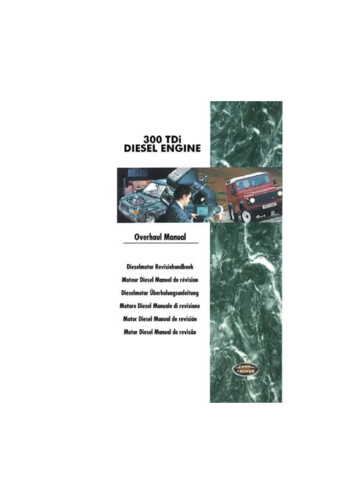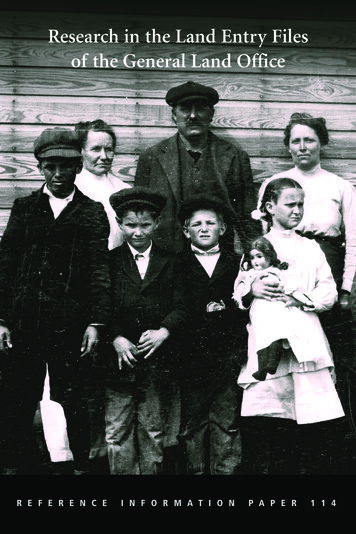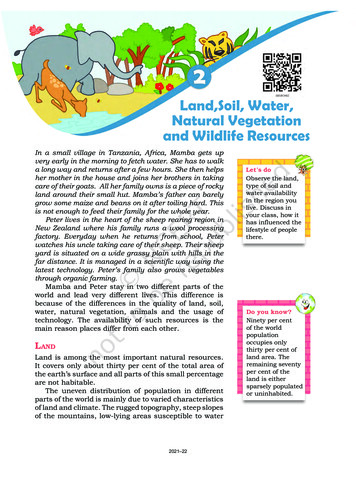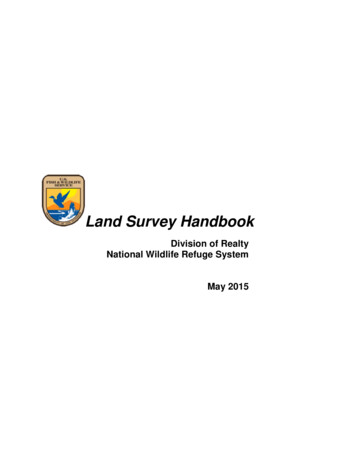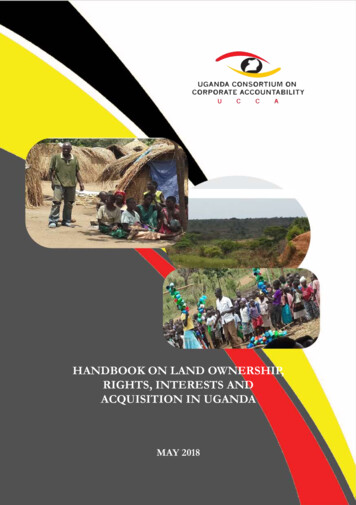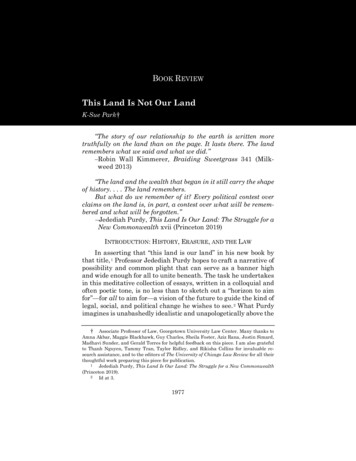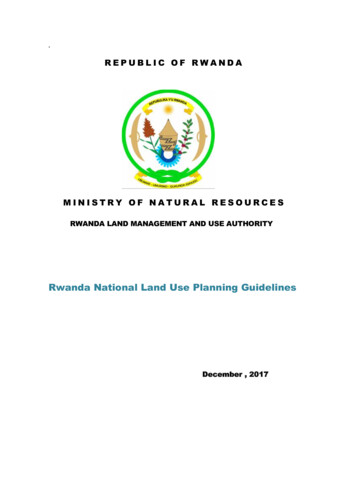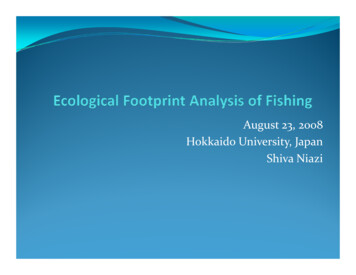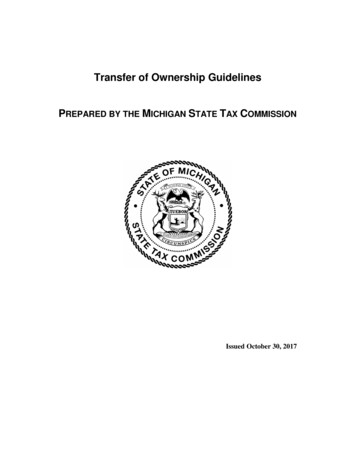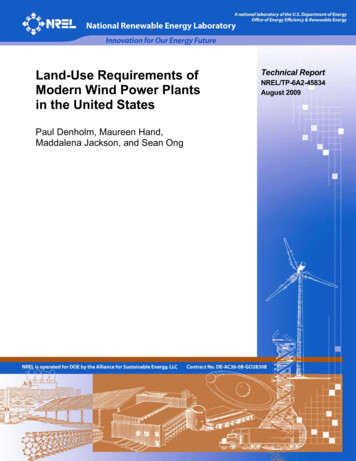
Transcription
Land-Use Requirements ofModern Wind Power Plantsin the United StatesPaul Denholm, Maureen Hand,Maddalena Jackson, and Sean OngTechnical ReportNREL/TP-6A2-45834August 2009
Land-Use Requirements ofModern Wind Power Plantsin the United StatesPaul Denholm, Maureen Hand,Maddalena Jackson, and Sean OngPrepared under Task No. WER9.3550National Renewable Energy Laboratory1617 Cole Boulevard, Golden, Colorado 80401-3393303-275-3000 www.nrel.govNREL is a national laboratory of the U.S. Department of EnergyOffice of Energy Efficiency and Renewable EnergyOperated by the Alliance for Sustainable Energy, LLCContract No. DE-AC36-08-GO28308Technical ReportNREL/TP-6A2-45834August 2009
NOTICEThis report was prepared as an account of work sponsored by an agency of the United States government.Neither the United States government nor any agency thereof, nor any of their employees, makes anywarranty, express or implied, or assumes any legal liability or responsibility for the accuracy, completeness, orusefulness of any information, apparatus, product, or process disclosed, or represents that its use would notinfringe privately owned rights. Reference herein to any specific commercial product, process, or service bytrade name, trademark, manufacturer, or otherwise does not necessarily constitute or imply its endorsement,recommendation, or favoring by the United States government or any agency thereof. The views andopinions of authors expressed herein do not necessarily state or reflect those of the United Statesgovernment or any agency thereof.Available electronically at http://www.osti.gov/bridgeAvailable for a processing fee to U.S. Department of Energyand its contractors, in paper, from:U.S. Department of EnergyOffice of Scientific and Technical InformationP.O. Box 62Oak Ridge, TN 37831-0062phone: 865.576.8401fax: 865.576.5728email: mailto:reports@adonis.osti.govAvailable for sale to the public, in paper, from:U.S. Department of CommerceNational Technical Information Service5285 Port Royal RoadSpringfield, VA 22161phone: 800.553.6847fax: 703.605.6900email: orders@ntis.fedworld.govonline ordering: http://www.ntis.gov/ordering.htmPrinted on paper containing at least 50% wastepaper, including 20% postconsumer waste
AcknowledgmentsSubstantial assistance in preparing this analysis, including the land-cover data, mapping,as well as general advice and guidance, was provided by Donna Heimiller, AneliaMilbrandt, and Billy Roberts at the National Renewable Energy Laboratory (NREL).Additional graphics and editorial support were provided by Jim Leyshon and MichelleKubik.i
Table of ContentsAcknowledgments . i1 Introduction .12 Wind Power Plant Land-Use Metrics .12.1 Direct Impact Area .42.2 Total Wind Plant Area .43 Wind Power Plant Land-Use Data .53.1 Direct Impact Area .63.2 Total Wind Plant Area .63.3 Wind Power Plant Land-Cover and Configuration Data .64 Results .94.1 Summary Results .104.2 Direct Impact Area Results .114.3 Total Area Results.135 Alternative Area Metrics and Measurement Methods .205.1 Habitat Impact Area .215.2 Uniform Estimation of Total Area Requirements .216 Conclusions .22References .24ii
List of FiguresFigure 1. Illustration of the two types of wind plant land use: total area and direct impactarea (including permanent and temporary) .3Figure 2. Example of direct impact area .6Figure 3. Examples of wind power plant configurations .8Figure 4. Locations of wind power plants evaluated in this study.9Figure 5. Distribution of permanent direct impact area .11Figure 6. Distribution of temporary direct impact area .12Figure 7. Distribution of total area requirements .14Figure 8. Distribution of total area expressed as capacity density .15Figure 9. Direct impact area requirements (hectare/MW) as a function of wind powerplant size .19Figure 10. Capacity density as a function of wind power plant size .20Figure 11. Possible methodologies for assigning uniform land metrics to total area ofwind power plants .22List of TablesTable 1. Summary of Collected Wind Power Plant Area Data.10Table 2. Projects with Detailed Direct Impact Data .13Table 3. Distribution of Direct Impact Area .13Table 4. Wind Power Plant Configuration.16Table 5. Land-Cover Data.17Table 6. Relationship between Configuration and Land-Use Area .18Table 7. Relationship between Land-Cover and Average Land-Use Area .18Table 8. Relationship between Land Cover and Configuration .19Table 9. Direct impact area requirements (hectare/MW) as a function of wind power plantsize .19iii
1 IntroductionBy the end of 2008, a combination of environmental, economic, and policy factorsresulted in the cumulative deployment of more than 25 gigawatts (GW) of windgeneration capacity in the United States (AWEA 2009a). Continued growth is anticipateddue to renewable portfolio standards and expected constraints on carbon emissions in theelectric sector. One of the concerns regarding large-scale deployment of wind energy isits potentially significant land use. Estimates of land use in the existing literature areoften based on simplified assumptions, including power plant configurations that do notreflect actual development practices to date. Land-use descriptions for many projects areavailable from various permitting agencies and other public sources, but we are not awareof any single source that compiles or summarizes this data. In addition, there is limitedinformation comparing land use for wind power plants across different terrain and plantconfigurations. The existing data and analyses limit the effective quantification of landuse impacts for existing and future wind energy generation, particularly in comparison toother electricity generation technologies.In this report, we provide data and analysis of the land use associated with modern, largewind power plants (defined as greater than 20 megawatts (MW) and constructed after2000). We begin by discussing standard land-use metrics as established in the life-cycleassessment literature, and then discuss their applicability to wind power plants. Weidentify two major “classes” of wind plant land use: 1) direct impact (i.e., disturbed landdue to physical infrastructure development), and 2) total area (i.e., land associated withthe complete wind plant project). We also provide data for each of these classes, derivedfrom project applications, environmental impact statements, and other sources. We alsoattempt to identify relationships among land use, wind plant configuration, andgeography. We evaluated 172 existing or proposed projects, which represents more than26 GW of capacity.In addition to providing land-use data and summary statistics, we identify severallimitations to the existing wind project area data sets, and suggest additional analysis thatcould aid in evaluating actual land use and impacts associated with deployment of windenergy.2 Wind Power Plant Land-Use MetricsThere are a number of existing and proposed metrics for evaluating land-use impacts.While there is no generally accepted methodology (Canals et al. 2007), review of the lifecycle assessment (LCA) literature suggests at least three general categories for evaluatingland-use impacts: 1) the area impacted, 2) the duration of the impact, and 3) the quality ofthe impact (Koellner and Scholz 2008).In this report, we focus on quantifying and summarizing the first component of land-useimpact identified above (area of impact), recognizing that the quality and duration of theimpact must be evaluated on a case-by-case basis. The quality of impact, which may alsobe stated as a “damage function,” evaluates both the initial state of the land impacted, and1
the final states across a variety of factors including soil quality and overall ecosystemquality (Koellner and Scholz 2008).Quantifying the area of a wind power plant is challenging given the discontinuous natureof its configuration. “Area” includes not only land directly disturbed by installation of theturbines, but also the surrounding area that potentially may be impacted. In reviewingvarious environmental impact assessments and other evaluations of wind plant land use,it appears that there are two general types of “areas” considered. The first is the directsurface area impact (i.e., disturbed land) due to plant construction and infrastructure. Thesecond is more vaguely defined, but is associated with the total area of the wind powerplant as a whole. Figure 1 provides a simplified illustration of the two types of areas,which are vastly different in both quantity and quality of impacts as discussed insubsequent sections.2
Figure 1. Illustration of the two types of wind plant land use: total area and direct impactarea (including permanent and temporary) 11The total project area map is adapted from an actual project application (U.S. DOE 2005). The directimpact area is a simplified illustration meant to represent typical components and does NOT represent thisor any actual project.3
2.1 Direct Impact AreaDevelopment of a wind power plant results in a variety of temporary and permanent(lasting the life of the project) disturbances. These disturbances include land occupied bywind turbine pads, access roads, substations, service buildings, and other infrastructurewhich physically occupy land area, or create impermeable surfaces. Additional directimpacts are associated with development in forested areas, where additional land must becleared around each turbine. While land cleared around a turbine pad does not result inimpervious surfaces, this modification represents a potentially significant degradation inecosystem quality (Arnett et al. 2007).In addition to permanent impacts, which last the life of the facility, there are temporaryimpacts from plant construction. These impacts are associated with temporaryconstruction-access roads, storage, and lay-down. After plant construction is completed,these areas will eventually return to their previous state. The amount of time required toreturn to its “pre-disturbance condition” is estimated at two-three years for grasslands and“decades” in desert environments (Arnett et al. 2007).An illustration of the direct impact area is shown in the magnified section of Figure 1,and demonstrates the components of direct impact, including the impermeable turbinepad and road, the permanently altered clearing around the turbine, and the temporary laydown area. This illustration is not meant to represent any specific project and the actualcomponents and configuration of direct impact area will vary among projects.2.2 Total Wind Plant AreaWhile the area and impacts associated with physical infrastructure described in Section2.1 may be the easiest to quantify, the more commonly cited land-use metric associatedwith wind power plants is the footprint of the project as a whole. However, unlike thearea occupied by roads and pads, the total area is more challenging to define andsubjective in nature. Generally, the total area of a wind power plant consists of the areawithin a perimeter surrounding all of the turbines in the project. However, the perimeteris highly dependent on terrain, turbine size, current land use, and other considerationssuch as setback regulations. An example of the total area of a project is illustrated inFigure 1, showing the individual turbine strings, and the very irregular perimeter. There isno uniform definition of the perimeter or boundary surrounding a wind power plant – infact, the total area of a wind power plant could have a number of definitions. Theboundary could be defined based on the required turbine spacing as a function of rotordiameter, or use a standardized setback from turbines at the edge of a project. Asdiscussed in Section 3, this paper relies on the area defined through project applicationsor other documentation associated with each project.The character of impact of the total area of a wind power plant is very different from thedirect impact area, or the area associated with other types of energy production facilities.Many previous comparisons of total land use associated with energy production onlyinclude the total area affected, and provide little discussion of the damage function as acomparative metric. A wind plant in an agricultural area with low population andminimum avian impacts would have a much lower damage function than an area minedfor coal or flooded by a hydropower project, for example. As a result, using the total area4
metric without qualification may significantly overstate the land impacts of wind powercompared to other sources. Alternatively, wind power projects should consider theimpacts associated with habitat disruption, avian impacts, and aesthetics. Ultimately, theactual quality of impacts, captured in a damage function, is needed to compare the landimpacts of wind to other sources.3 Wind Power Plant Land-Use DataOur goal was to collect and provide a summary of reported land-use data associated withmodern, large wind power plants. As a result, we restricted the sample of sites to projectsconstructed after 2000 and with a nameplate capacity greater than 20 MW. 2 We includedproposed projects, but only those with detailed, formal applications (or environmentalassessments) to a regulatory agency.A variety of sources for land-use data were used for this study and fell into three generalcategories. First, where available, we collected official project data from federal, state,and local regulatory agencies, including environmental impact statements (EIS),environmental assessments (EA), and project applications to utility regulatory bodies.The availability of this data is highly dependent on state and local regulations. Somestates require very detailed environmental assessments, while others require little in theway of analysis of potential land use. Second, we collected project fact sheets, newsreleases, and other data provided by the project owner or developer. When no othersource of data could be located, we used news articles, Web sites and other secondarysources. As a supplement to area data, we also collected location and land-cover data forindividual turbines from publicly available data sets. The following sections providedetails about the specific types and sources of data collected.3.1 Direct Impact AreaThe direct impact area was identified in project materials as land “permanentlyoccupied,” “permanently disturbed,” or using similar wording. When provided, mostprojects report a single number for land directly occupied; however, some provide abreakdown of occupation categories. Figure 2 provides an example of a detailed table ofoccupied area from a project application.2We excluded older projects largely because they use turbines less than 1 MW. This excludes several largeprojects such as those in the Altamont Pass and Tehachapi regions in California.5
Figure 2. Example of direct impact area (adapted from BLM 2008)When provided, we recorded the permanent direct impact area data for five categories:turbine pad, roads, substations, transmission, and other.A number of applications also included temporary direct impact data associated withplant construction. We recorded temporary direct impact area data in four categories:temporary roads, staging, substation/transmission construction, and other.3.2 Total Wind Plant AreaThe total area was identified in project materials as “project area,” “lease area,” “siteboundary,” or similar terms. This area is not uniformly defined, and is often establishedby the individual project developer; it also will vary between developers and betweenstates. In addition, many applications define the project area without a map or anyadditional information about how this boundary is determined.3.3 Wind Power Plant Land-Cover and Configuration DataIn addition to area data, two additional parameters associated with wind plants werecollected to aid in evaluating possible dependence of land use on wind plantconfiguration and location.For each wind power plant evaluated, we collected location data for each turbine in theproject from the Federal Aviation Administration (FAA 2009). This data set includeslatitude and longitude for each turbine. From this database, we then acquired the landcover type for each turbine using a U.S. Geological Survey data set (USGS 2006). Landcover in this data set is described as “the nature of the land surface at a particularlocation” with 21 classes of land cover. This data provides additional insight into thepotential impact – for example, turbines located in primarily agriculture area should have6
significantly less impact than turbines located in forested area, which are more likely torequire additional clearing and have a greater potential for habitat fragmentation andother adverse environmental impacts.Once we collected the location data for each turbine, we also examined the overall windplant configuration to identify relationships between land-use area and configuration.After examining the various configurations, we created four general categories: SingleString, Multiple Strings, Parallel Strings, and Clusters. These are qualitatively defined asfollows: Single String: A single long string of turbines, including projects with one ormore discontinuities. Multiple String: A series of identifiable strings of turbines, but not uniformlyoriented. Parallel String: A series of well-defined strings that are roughly parallel to eachother (i.e., strings do not intersect). This configuration is closest to the gridspacing often used to represent an “ideal” plant layout. Cluster: Sites that have very few to no observable turbine strings.Examples of these configurations are provided in Figure 3.7
Figure 3.1. Single string configuration(Waymart, Pennsylvania)Figure 3.2. Multiple strings configuration(Wyoming Wind Energy Center,Wyoming)Figure 3.3. Parallel string configuration(Roscoe Wind Project, Texas)Figure 3.4. Cluster configuration (SpringCreek Wind Farm, Illinois)Figure 3. Examples of wind power plant configurationsIn these representative cases, the different configurations are easily visible. However, it issometimes difficult to establish a single, uniform configuration for an entire plant, whichintroduces an element of subjectivity to this metric.8
4 ResultsWe obtained one or more categories of land-use data for 172 individual projects,representing 26,462 MW of proposed or installed capacity. Of this capacity, 19,834 MWwas completed as of March 2009, 2,892 MW was under construction, and the remainderconsists of proposed projects. According to a the American Wind Energy Association(2009b), as of March 2009, 28,206 MW wind capacity had been completed in the UnitedStates, with 24,640 MW meeting our criteria as a large modern plant with a capacity of atleast 20 MW and constructed after 2000. As a result, we collected at least someinformation on about 80% of the targeted installed wind capacity in the United States.Figure 4 provides a map of project locations. A complete listing of all projects, datasources, and individual project data is provided in the Appendix.Figure 4. Locations of wind power plants evaluated in this study9
4.1 Summary ResultsTable 1 summarizes the direct impact area data and total area data for projects shown inFigure 4 and listed in the Appendix. As noted earlier, this represents a mix of data fromthe 172 projects. The number of projects where we obtained data for the correspondingarea metric is listed in the first row of Table 1 – for example, we were able to obtain totalimpact area for 161 of the 172 projects, but only 52 of the projects had information on thetemporary direct impact area. The average area requirements (hectare/MW) werecalculated by summing the total area of all plants with corresponding land-use data anddividing by the total capacity of those plants. 3Table 1. Summary of Collected Wind Power Plant Area DataData TypeNumber of Projectswith CorrespondingDataTotal Capacity (MW)with CorrespondingDataTotal Number ofTurbines withCorresponding DataTotal Reported Area(km2)Average AreaRequirements(hectare/MW) 4Direct Impact AreaTotal 15,54115,87137.661.48,778.90.3 0.30.7 0.634.5 22.43This represents a weighted average and is not equal to the simple average. The simple average would sumeach individual land use requirement (area per unit capacity) and the divide the sum by the total number ofevaluated projects. This method would weight each wind plant equally, so that the land use “intensity” of asmall plant would count as much as a much larger project.4The standard deviation is also reported. It should be noted that the data sets do not represent normaldistributions as can be observed in Figures 5-7.10
4.2 Direct Impact Area ResultsThere is substantial variation among the reported area requirements as indicated by thelarge standard deviation values. For the permanent direct impact, the range is about 0.06hectares/MW to about 2.4 hectares/MW; however, approximately 80% of the projects(both number of projects and total capacity) report direct land use at below 0.4hectares/MW. Figure 5 indicates the range of direct impact area for the projects thatprovided this data. In this figure, the data were binned and reported as both the number ofprojects and the total capacity (MW) in each bin of direct impact area (hectares/MW).MW35600030500025400020300015MWNumber of ProjectsNumber of Projects2000105100000 0.10.1-0.20.2-0.30.3-0.40.4-0.50.5-1.01-1.5 1.5Permanent Direct Impact Area (Hectares/MW)Figure 5. Distribution of permanent direct impact areaFigure 6 provides the distribution of temporary direct impact area. The temporary impactarea is much higher than the permanent area, with about 50% of the projects (bothnumber and capacity) reporting a temporary impact area of greater than 0.5 hectares/MW.11
Number of ProjectsMW25001420001015008MWNumber of Projects12610004500200 0.10.1-0.20.2-0.30.3-0.40.4-0.50.5-1.01-1.5 1.5Temporary Direct Impact Area (Hectares/MW)Figure 6. Distribution of temporary direct impact areaThe overall average direct impact area is 0.3 0.3 hectares/MW for permanent impactand 0.7 0.6 hectares/MW for temporary impact, or a total direct surface area disruptionof about 1.0 0.7 hectares/MW.The reported values can be compared to previous estimates of direct impacts. The Bureauof Land Management (BLM 2005) estimated a direct impact area (both permanent andtemporary) of 0.4 to 1.2 hectares per turbine in the western United States. Assuming a 1.5MW turbine, this corresponds to total direct impact area of 0.3 to 0.8 hectares/MW.Strickland and Johnson (2006) estimate permanent infrastructure impacts of 0.3 to 0.4hectares per turbine, and temporary impacts of 0.2 to 1.0 hectares per turbine. Assuminga 1.5 MW turbine, this corresponds to a permanent impact area of 0.2 to 0.5 hectares/MWand temporary impact area of 0.1 to 0.7 hectares/MW.Where provided, we collected data that breaks out the occupation categories as describedpreviously. Less than a third of the projects that reported direct impact area provideddetailed data. Tables 2 and 3 provide summary statistics of this data.12
Table 2. Projects with Detailed Direct Impact DataNumber of Projects withDetailed DataTotal MWPermanentTemporary23174,2573,642Table 3. Distribution of Direct Impact AreaPermanent ImpactCategoryTurbine AreaRoadsSubstationTransmissionOther% of Area10%79%6%2%2%Temporary ImpactCategoryStaging AreaTemp RoadsSub/TransconstructionOther% of Area30%62%6%3%Table 3 indicates that the majority of direct impacts are associated with roads. In mostcases, the road area provided in the documents only counts new road development orroad improvement. For further studies, it would be useful to more closely review projectdocuments to determine the amount of new roads that were constructed versus the extentto which the project used the preexisting road network.4.3 Total Area ResultsFor total area requirements, the range of values is from about 9 hectares/MW to 100hectares/MW, with five “outliers” – three projects with requirements below 6hectares/MW and two projects with reported areas of greater than 135 hectares/MW.Figure 7 provides a distribution of the total area requirements (hectares/MW).13
Number of ProjectsMW60900080007000600040500030400020MWNumber of Projects503000200010100000 1010-2020-3030-4040-5050-6060-70 70Total Project Area (Hectares/MW)Figure 7. Distribution of total area requirementsMany estimates of total area often express wind plant land use in terms of capacitydensity (capacity per unit area, typically MW/km2). Excluding the outliers, the reporteddata represents a capacity density range of 1.0 to 11.2 MW/km2 and an overall averagecapacity density of 3.0 1.7 MW/km2. Figure 8 provides a distribution of the capacitydensity data. Of the 161 projects with total land-use area data, 125 (representing 80% ofthe evaluated capacity) have reported area of between 10 and 50 hectares/MW (or acapacity density range of 2-10 MW/km2).14
Number of ProjectsMW40600050003040002520300015MWNumber of Projects352000101000500 11--22--33--44--55--66--77--8 8Capacity Density (MW/km2)Figure 8. Distribution of total area expressed as capacity densityPrevious estimates of total area are often based on theoretical potential to extract energyover a particular area, such as the U.S. DOE (2008) estimate of 20 hectares/MW (equal toa capacity density of 5 MW/km2). Other estimates assume turbines are configured in agrid with a fixed array spacing, such as 5 rotor diameters by 10 rotor diameters (a 5D by10D array), or some alternative fixed spacing (Manwell et al. 2002, Fthenakis and Kim2009). For modern wind turbines, a 5D by 10D array yields an area of 13-20hectares/MW, equal to a capacity density of 5-8 MW/km2 (Denholm 2006). Theseestimates represent minimum spacing to optimize energy extraction.The overall average land use reported in this study is higher than estimates that useoptimal grid spacing due, in part, to irregular spacing seen in actual projects. However, inreviewing the project applications and environmental assessments, we found severalpotentially significant sources of overestimates of the land use associated with someprojects.In some cases, developers lease (or propose to lease) all the land deemed necessary for amultiphase project at once, and all of that land then gets associated with an initial phaseof the project rather than the final (larger) project.We have also found that in several states, project areas are mapped based on discretesections (where a section is defined as a 1 square mile parcel 5), and t
National Renewable Energy Laboratory 1617 Cole Boulevard, Golden, Colorado 80401-3393 303-275-3000 www.nrel.gov NREL is a national laboratory of theU.S. Department of Energy
